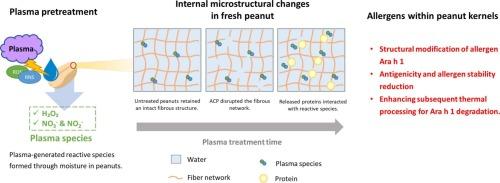水分依赖的冷等离子体预处理增强花生热处理过程中过敏原Ara h 1的减少
IF 9.8
1区 农林科学
Q1 CHEMISTRY, APPLIED
引用次数: 0
摘要
食物过敏影响着全球数百万人,花生是一种常见的过敏原。大气冷等离子体(ACP)显示出通过改变蛋白质结构减少过敏原的潜力,但在穿透固体食物方面面临挑战。本研究探讨了花生内部水分如何促进ACP渗透和过敏原减少。不同含水率(0 % -30 %)的生花生仁用ACP处理。采用免疫印迹(western blot)和酶联免疫吸附试验(ELISA)检测Ara h 1蛋白,分析血浆蛋白结构、微观结构和活性物质。结果表明,湿度与Ara h 1降解率呈正相关(R2 = 0.997)。二级结构和微观结构分析显示,只有水合花生和新鲜花生的结构发生了变化,表现出较高的反应物质。等离子体处理也降低了热稳定性,焙烧/煮沸进一步降低了Ara h 1含量,分别降至0.6 %和0.3 %。因此,水分增强了等离子体的渗透,促进了Ara h 1的降解,表明冷等离子体是降低花生过敏原的有希望的预处理。本文章由计算机程序翻译,如有差异,请以英文原文为准。

Moisture-dependent cold plasma pretreatment enhances allergen Ara h 1 reduction during heat processing in peanuts
Food allergy affects millions worldwide, with peanuts being a common allergen. Atmospheric cold plasma (ACP) shows potential for reducing allergens by modifying protein structures but faces challenges in penetrating solid foods. This study investigates how internal moisture enhances ACP penetration and allergen reduction in peanuts. Raw peanut kernels with varying moisture contents (0 %–30 %) were treated with ACP. Ara h 1 was evaluated with western blot and ELISA, while protein structure, microstructure, and reactive species from plasma were analyzed. Results showed moisture positively correlated with Ara h 1 degradation (R2 = 0.997). Secondary structure and microstructure analyses revealed structural changes only in rehydrated and fresh peanuts, which showed higher reactive species. Plasma treatment also reduced in heat stability, and roasting/boiling further decreased Ara h 1 content to 0.6 % and 0.3 %, respectively. Therefore, moisture enhanced plasma penetration and facilitated Ara h 1 degradation, suggesting cold plasma as a promising pretreatment to reduce peanut allergenicity.
求助全文
通过发布文献求助,成功后即可免费获取论文全文。
去求助
来源期刊

Food Chemistry
工程技术-食品科技
CiteScore
16.30
自引率
10.20%
发文量
3130
审稿时长
122 days
期刊介绍:
Food Chemistry publishes original research papers dealing with the advancement of the chemistry and biochemistry of foods or the analytical methods/ approach used. All papers should focus on the novelty of the research carried out.
 求助内容:
求助内容: 应助结果提醒方式:
应助结果提醒方式:


